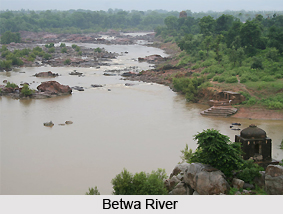 Geography of Lalitpur District forms a portion of the hill country of Bundelkhand. It is sloping down from the outliers of the Vindhya Range on the south to the tributaries of the Yamuna River on the north. Extreme south of the district is composed of parallel rows of long and narrow-ridged hills. Through the intervening valleys the rivers flow down over ledges of granite or quartz. North of the hilly region, the granite chains gradually turn into clusters of smaller hills.
Geography of Lalitpur District forms a portion of the hill country of Bundelkhand. It is sloping down from the outliers of the Vindhya Range on the south to the tributaries of the Yamuna River on the north. Extreme south of the district is composed of parallel rows of long and narrow-ridged hills. Through the intervening valleys the rivers flow down over ledges of granite or quartz. North of the hilly region, the granite chains gradually turn into clusters of smaller hills.
The climate of Lalitpur District is the Central India type sub-tropical and may be characterized by a very hot dry summer and cold winter. Like other districts of the Bundelkhand region, this also shows four distinct seasons. Summer season from March to mid-June, Monsoon from mid-June to September, post-monsoonal transition between October and November while the winter months are December to February. The day temperature is the highest during May and June which falls steeply with the onset of monsoon in mid-June or July. It rises again around September and goes a little higher during October. Then with the beginning of winter, the temperature falls and becomes minimal in January.
Betwa River forms the northern and western boundary of the geography of Lalitpur District, and most of the district lies within its watershed. Jamni River, a tributary of the Betwa, forms the eastern boundary of the district. Dhasan River forms the district`s south-eastern boundary, and the south-eastern portion of the district lies within its watershed. Topography of Lalitpur District is generally rocky. The highest ground is in the extreme south with scraps of the Vindhya plateau, running from the Betwa in south-easterly direction and gradually breaking up into a confined mass of hills, parts of which approach a height of 650 metres above mean sea level. The north of the scrap, undulating plain of Regur soil interrupted with scattered hills and scoured by numerous drainage channels, stretches north beyond the town of Lalitpur and gradually becomes rockier. Low red hills of granite rock appear with long ridges running from south- west to north- west.
Most of the area of Lalitpur District is drained by river Jamni and its tributaries which form its eastern boundary, separating it from Tikamgarh district. River Betwa forms the western and northern boundary and drains the western part of the district. The south eastern part is partly drained by Dhasan River. In general the slope is towards the north. The hills in the south generally occur in small groups or in continuous narrow chain running parallel to each other from north-east to south-west, the ridges being mostly bare and sharp. The slopes are still comparatively more covered with scrub jungles. The plateau is intersected by wide valleys particularly in the south west. Mining has affected the whole area considerably. From the base of the plateau to the town of Lalitpur stretches a black soil plain which is dissected by a number of seasonal rivulets and is characterized by an undulating topography.
The soils of Lalitpur District are also representative of typical Bundelkhand varieties of soils. The soils here have developed from Vindhya ranges of rocks which in this area are formed of gneiss, granite, quartzite and at times sandstone, limestone and slate. The soils of the district are divided into two broader categories - Black Soil and Red Soil groups. A strip of alluvial soil is also found in the western part of Lalitpur District.



















